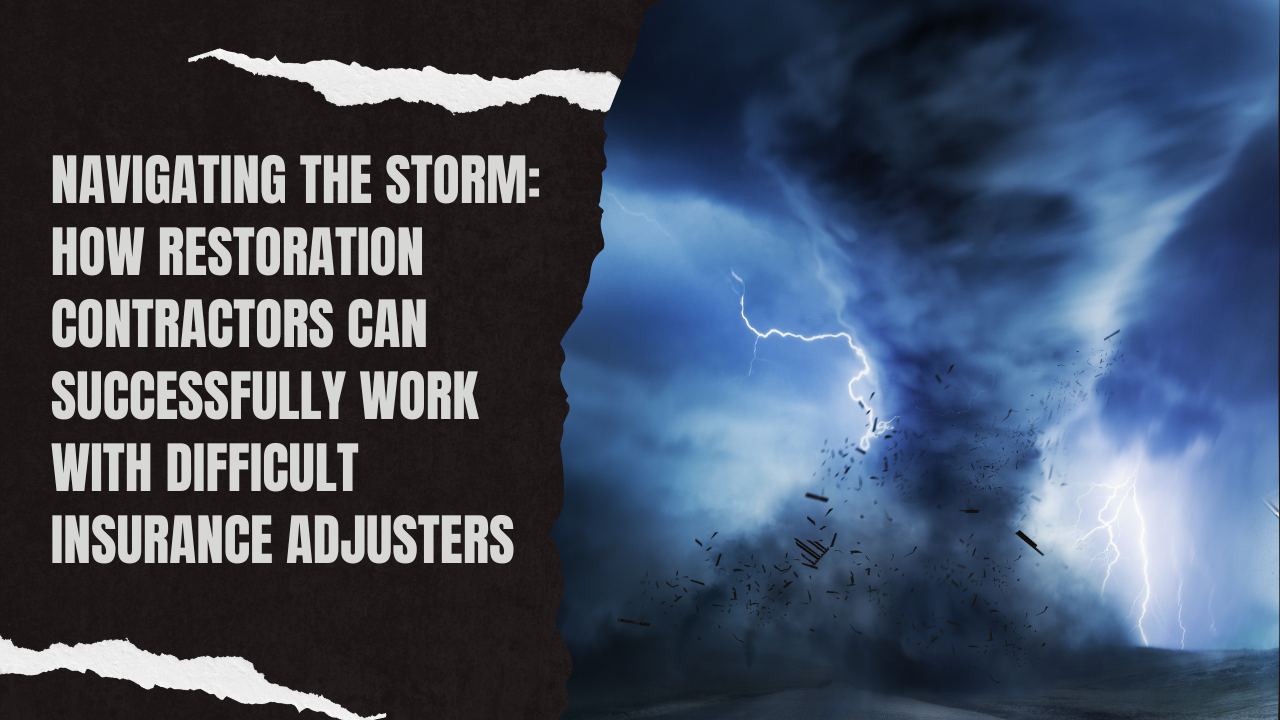Navigating the Storm: How Restoration Contractors Can Successfully Work with Difficult Insurance Adjusters
Amidst the roaring winds and crashing waves of the restoration industry, there exists a tale of how contractors and insurance adjusters, like seasoned sailors, can navigate the storm and chart a course to successful collaboration. However, for many restoration contractors, working with difficult insurance adjusters can pose unique challenges. There are many practices and strategies restoration contractors can implement to establish effective working relationships with difficult insurance adjusters. By understanding their perspectives, maintaining clear communication, documenting thoroughly, and prioritizing professionalism, contractors can navigate stormy waters and achieve mutually beneficial outcomes while making the adjuster’s life easier.
1. Make the Adjuster’s Life Easier:
To effectively work with difficult insurance adjusters, it is crucial to empathize and understand their perspective. Adjusters often face high workloads, tight deadlines, and pressure to control costs. Recognizing these challenges can help contractors approach interactions with empathy and patience, fostering a more positive and productive working relationship.
Restoration contractors can take steps to make the adjuster’s job more manageable, ultimately facilitating a smoother process. Providing clear and concise documentation, including detailed estimates and supporting photographs, reduces the adjuster’s workload and allows for quicker assessments. Additionally, prompt responses to inquiries, efficient scheduling of inspections, and proactive updates on progress demonstrate professionalism and assist adjusters in managing their caseload effectively.

2. Prioritize Clear and Open Communication:
Clear and open communication is the cornerstone of successful collaborations. Restoration contractors should establish effective lines of communication with insurance adjusters from the outset of the project. Regularly update them on the progress, any significant developments, and potential challenges encountered. Address any concerns promptly and professionally, ensuring that all parties are on the same page throughout the restoration process.
3. Document Thoroughly:
Comprehensive documentation is vital for demonstrating the scope of work, the extent of damages, and the necessity of restoration efforts. Detailed documentation provides solid evidence to support your claims and can help alleviate any disputes with difficult adjusters. Capture photographs, videos, and written reports that thoroughly depict the pre and post-damage conditions, providing clear visual evidence of the work required.

4. Educate Yourself on Policy Coverage, but Understand your Boundaries:
Understanding insurance policies and coverage is an invaluable asset for restoration contractors. Familiarize yourself with the specific terms, limitations, and exclusions of policies related to the projects you undertake. This knowledge equips you to communicate effectively with adjusters, understand covered damages, and present the necessary documentation to support your claims.
While restoration contractors protect their own interests by understanding how policies work, it is essential to avoid crossing over into the role of a public adjuster. Engaging in public adjusting without the appropriate licenses and qualifications is illegal in many jurisdictions and can lead to severe consequences. Restoration contractors should focus on providing expert restoration services, presenting documentation, and collaborating with adjusters within the established boundaries of their professional roles.
5. Be Professional and Courteous:
Maintaining a professional and courteous demeanor is crucial, even in challenging situations. Treat insurance adjusters with respect and professionalism, regardless of their behavior. Remaining calm, focused, and respectful in interactions helps foster a more cooperative environment, increasing the chances of reaching favorable resolutions.
6. Utilize Technology and Data:
Leveraging technology and data can streamline processes and enhance collaboration with difficult insurance adjusters. Utilize restoration management software, cloud-based platforms, and mobile applications to efficiently share documentation, progress updates, and communications. Data-driven insights and analytics can help validate the necessity of restoration work and support negotiations.

7. Seek Professional Assistance if Needed:
In challenging situations with difficult adjusters, restoration contractors can seek professional assistance to navigate complex disputes. At the Law Offices of Edward H. Cross, we have unparalleled expertise and resources to assist restoration contractors in dealing with difficult adjusters. We can provide valuable guidance, advocate on your behalf, and help resolve disputes in a fair and equitable manner.
Working successfully with difficult insurance adjusters requires patience, effective communication, and a thorough understanding of the restoration process. Restoration contractors should provide expertise in restoration services, collaborate within established boundaries, and engage professional assistance when necessary. By embracing empathy, clear communication, and comprehensive documentation, restoration contractors can weather the tempest and forge productive partnerships with even the most challenging insurance adjusters. So, set sail with professionalism and expertise, knowing that success lies on the horizon.






